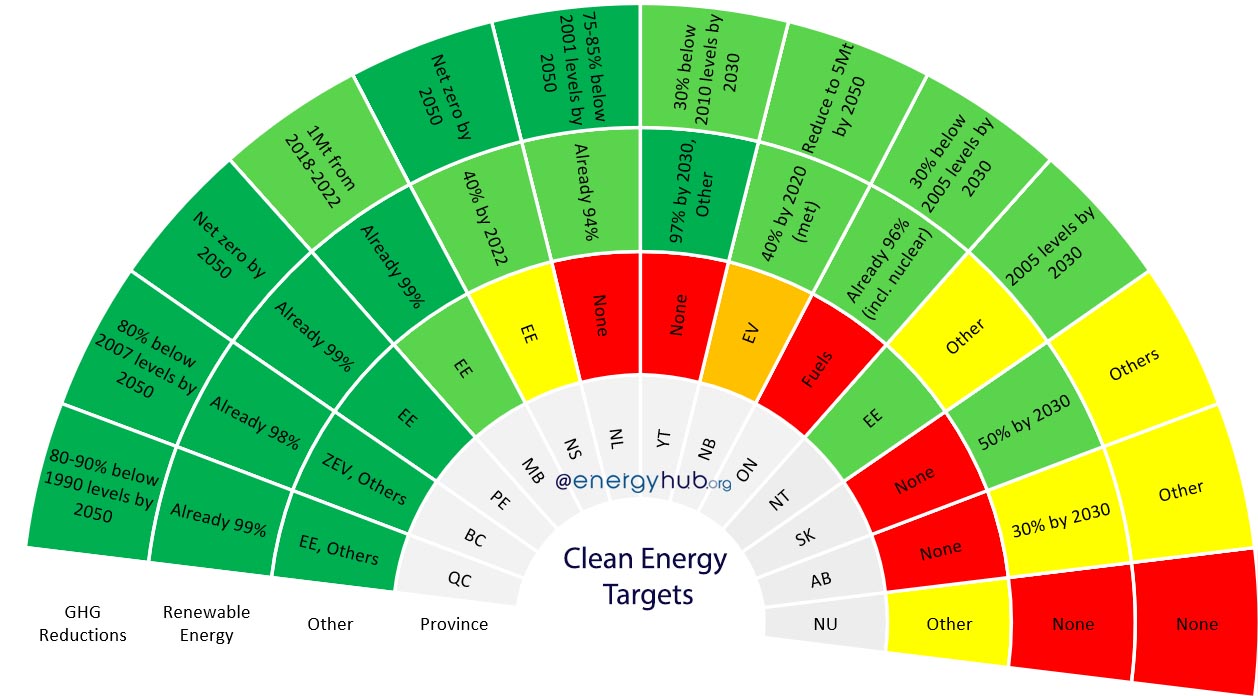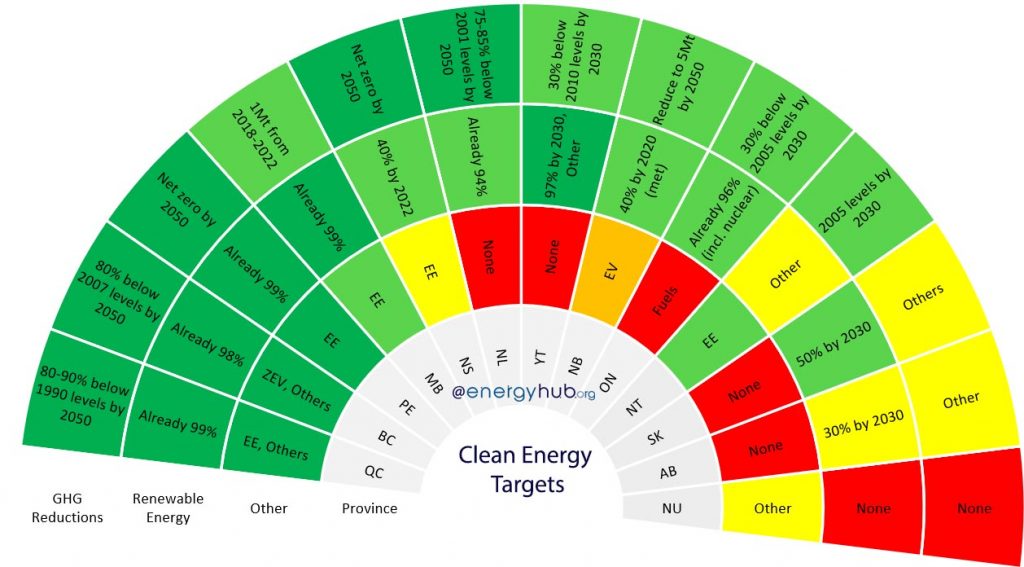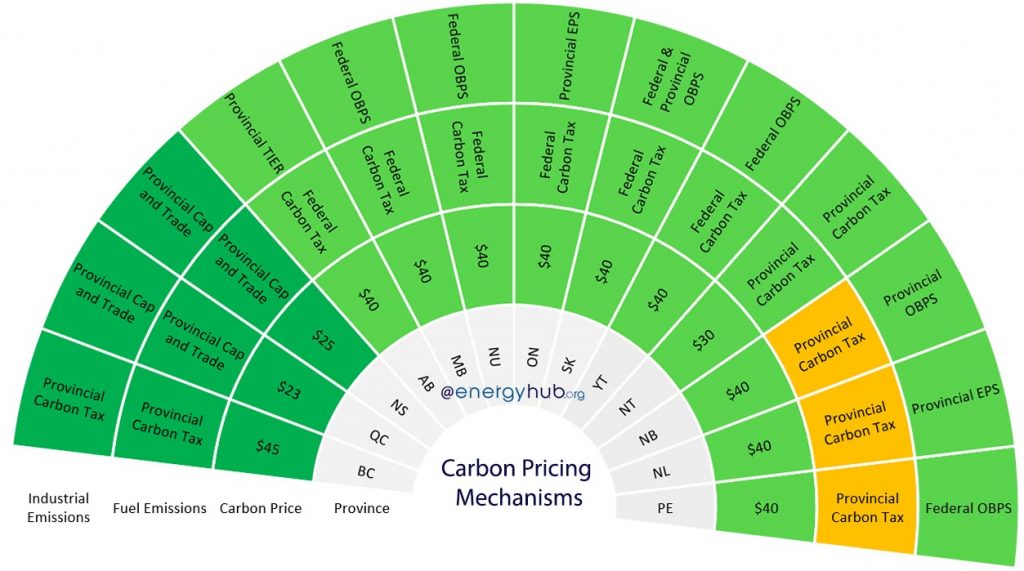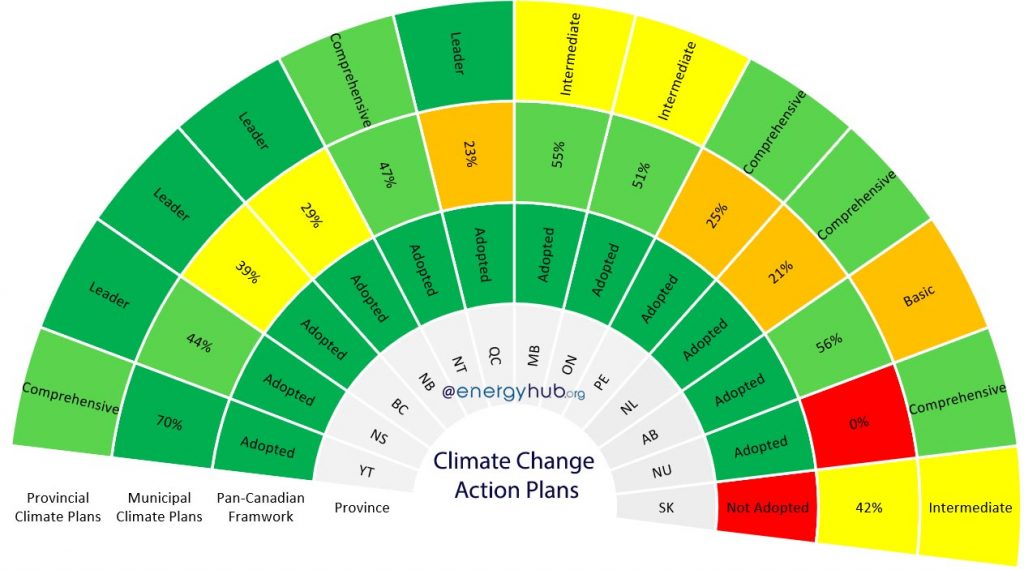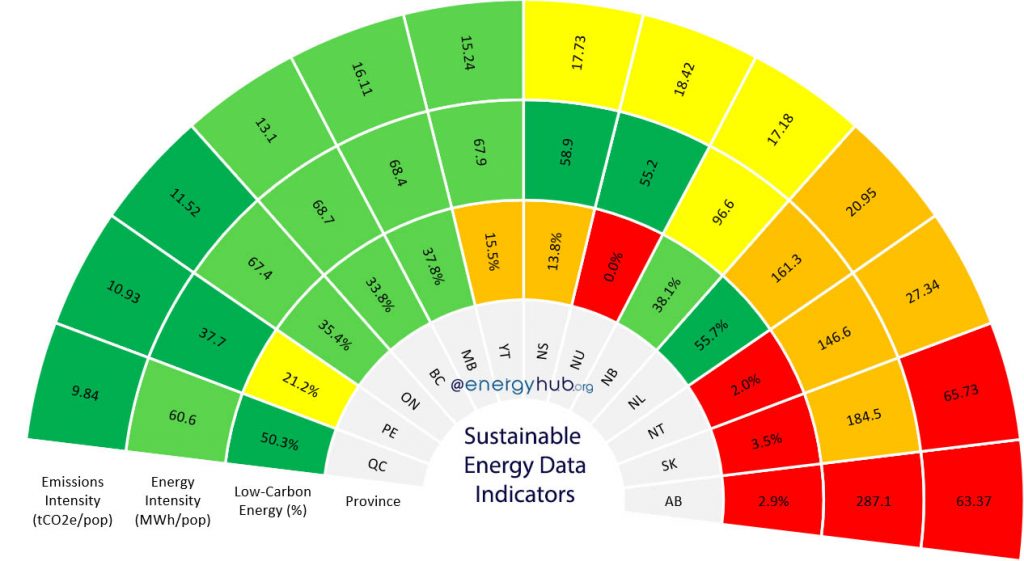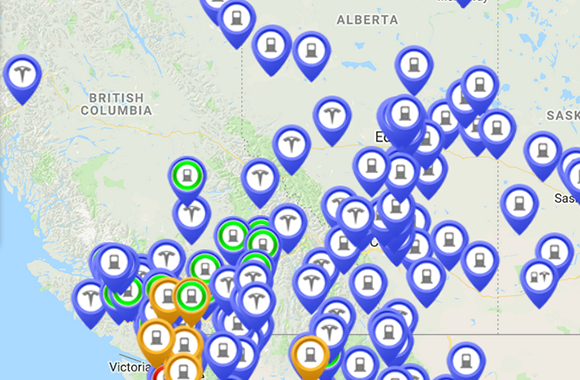Clean Energy Targets Canada (Updated 2024)
Published by Rylan Urban on Nov 1, 2020. Last updated by Chloe McElhone on Aug 17, 2023.
There are at least 42 federal and provincial clean energy targets in Canada. Twelve provinces and territories have greenhouse gas (GHG) reduction targets, seven have renewable energy targets, and nine have other clean energy goals.
Clean energy targets on this page are sorted by the province and territory. Start your clean energy target search by clicking on you jurisdiction below:
Canada-Wide Climate and Energy Targets

Canada currently releases approximately 670 million metric tonnes of carbon dioxide equivalent emissions every year (tCO2e).
You can view Canada’s emissions intensity (by population and GDP) on our Clean Energy Data Indicators page.
Greenhouse Gas Reduction Targets
- Federal GHG Reduction Target – Canada has a target to reduce GHG emissions by 40-45% below 2005 levels by 2030, and to have a net-zero emissions economy by 2050. The 2030 target is more ambitious than it’s previous target to reduce emissions 30% over the same time frame.
- Federal Methane Reduction Target – In November 2021, Canada joined the Global Methane Pledge to reduce methane emissions by 30% below 2020 levels by 2030.
- Federal O&G Methane Reduction Target – Canada has a target to reduce methane emissions in the oil and gas sector by 40-45% below 2012 levels by 2025. However, in November 2022 Canada published proposed methane regulations framework to reduce oil and gas emissions by 75% by 2030.
Renewable Energy Targets
- Federal Clean Electricity Target – Canada has a target to generate net-zero electricity by 2035, which is further supported by the Clean Electricity Standard in development. This is updated from it’s previous target to generate 90% of electricity from non-emitting sources by 2030.
Other Clean Energy Targets
- Federal Energy Efficiency Target – Canada is part of the Three Percent Club with the target to improve energy efficiency by 3% annually. It also has a target of implementing Net Zero Energy Ready building codes by 2030.
- Federal Zero-Emission Vehicle Sales Target – Canada has accelerated its target for zero-emission vehicles to make up 100% of all new light duty vehicle sales by 2035. This is compared to its previous target of 2040. It also has plans to have a national EV charging network in place by 2030. See a map of all EV chargers available today.
Provincial Climate and Energy Targets
This table shows the total carbon dioxide equivalent emissions released by the provinces and territories each year. You can view provincial emissions intensity (by population and GDP) on our Clean Energy Data Indicators page.
Alberta

Alberta currently releases approximately 256 million metric tonnes of carbon dioxide equivalent emissions every year (tCO2e).
Greenhouse Gas Reduction Targets
- GHG Reduction Target – In Alberta’s Emissions Reduction and Energy Development Plan, the province aspires to achieve a carbon neutral economy by 2050.
- O&G Methane Reduction Target – Alberta has a target to reduce methane emissions in the oil and gas sector by 45% below 2014 levels by 2025. However, this only accounts for 70% of Alberta’s methane emissions. The other 30% comes from the agriculture and waste sectors.
Renewable Energy Targets
- Renewable Energy Target – Alberta has a target to generate 30% of its electricity from renewable sources by 2030. This includes interim targets of 15% by 2022, 20% by 2025, and 26% by 2028. Alberta also plans to phase out coal by 2030. In 2022, Alberta achieved the 15% target.
British Columbia

British Columbia currently releases approximately 59 million metric tonnes of carbon dioxide equivalent emissions every year (tCO2e).
Greenhouse Gas Reduction Targets
- GHG Reduction Target – British Columbia has a target to reduce GHG emissions by 80% below 2007 levels by 2050. This includes interim targets of 40% by 2030 and 60% by 2040. The CleanBC Roadmap to 2030 also accelerates these targets to close the gap to our climate goals and put B.C. on the path to net zero emissions by 2050.
Other Clean Energy Targets
- Zero Emissions Vehicle Sales Target – British Columbia has a target for zero-emission vehicles to make up 100% of new light-duty vehicle sales by 2040. This includes an interim target of 30% by 2030 and 10% by 2025.
- Building Efficiency Target – British Columbia has a goal to make all new buildings net-zero energy ready by 2032. This includes interim targets for new homes to be built 20% more energy efficiency by 2022, 40% by 2027, and 80% by 2032.
- Low-Carbon Fuel Target– British Columbia has a target of increasing their low-carbon fuel standard to 20% by 2030.
- Other Sectoral Targets – The Climate Change Accountability Act establishes additional provincial targets for four sectors against a 2007 baseline: 27-32% in transportation, 38-43% in industry, 33-38% in oil and gas, and 59-64% in buildings and communities.
Manitoba

Manitoba currently releases approximately 21 million metric tonnes of carbon dioxide equivalent emissions every year (tCO2e).
Greenhouse Gas Reduction Targets
- GHG Reduction Target – Manitoba has a target to reduce GHG emissions by 5.6 MT over the 2023-2027 period.
Other Clean Energy Targets
- Energy Efficiency Target – Manitoba has a goal of improving electricity energy efficiency by 1.5% annually and gas energy efficiency by 0.75% annually.
New Brunswick

New Brunswick currently releases approximately 12 million metric tonnes of carbon dioxide equivalent emissions every year (tCO2e).
Greenhouse Gas Reduction Targets
- GHG Reduction Target – New Brunswick had a target to reduce total GHG emissions to 14.8Mt by 2020 (this has been achieved), 10.7Mt by 2030, and 5Mt by 2050. These targets are not yet reported as a percent reduction target.
Renewable Energy Targets
- Renewable Energy Target – New Brunswick had a target to reduce total GHG emissions to 14.8Mt by 2020 (this has been achieved). The province also has the goals to reduce GHG emissions by 46% below 2005 levels by 2030 and achieve net-zero emissions by 2050.
Other Clean Energy Targets
- Electric Vehicle Sales Target – New Brunswick has a target to have 20,000 electric vehicles on the road by 2030.
Newfoundland and Labrador

Newfoundland and Labrador currently releases approximately 8 million metric tonnes of carbon dioxide equivalent emissions every year (tCO2e).
Greenhouse Gas Reduction Targets
- Greenhouse Gas Reduction Target – Newfoundland and Labrador has a target to reduce emissions by 75-85% below 2001 levels by 2050. More recently, this target was updated in the Renewable Energy Plan to achieve net-zero emissions by 2050.
Northwest Territories

The Northwest Territories currently release approximately 1.3 million metric tonnes of carbon dioxide equivalent emissions every year (tCO2e).
Greenhouse Gas Reduction Targets
- Greenhouse Gas Reduction Target – Northwest Territories has set and reached their target to reduce GHG emissions to 2005 levels by 2030. They now have a goal to reduce electricity generation emissions in diesel communities by 25% by 2030, and reduce transportation emissions by 10% on a per person basis.
Renewable Energy Targets
- Renewable Energy Target – Northwest Territories has a target to increase the share of renewable energy used for space heating to 40% by 2030.
Other Clean Energy Targets
- Building Energy Efficiency Target – Northwest Territories has a target to increase building energy efficiency by 15% over 2015 levels by 2030.
Nova Scotia

Nova Scotia currently releases approximately 15 million metric tonnes of carbon dioxide equivalent emissions every year (tCO2e).
Greenhouse Gas Reduction Targets
- Greenhouse Gas Reduction Target – Nova Scotia has a target to reduce GHG emissions by 53% below 2005 levels by 2030, and to achieve net-zero emissions by 2050.
Renewable Energy Targets
- Renewable Energy Target – Nova Scotia has a target to reduce emissions in the electricity sector by 55% by 2030. Nova Scotia also has a goal to generate 80% of electricity from renewable sources by 2030. They are currently on track to reach 70% by 2025-26.
Energy Efficiency Targets
- Indigenous Energy Efficiency Target – The Mi’kmaw Home Energy Efficiency project has the goal of providing energy efficiency upgrades to 80% of the 2,400 band-owned homes on the reserves by 2030.
Nunavut

Nunavut currently releases approximately 0.6 million metric tonnes of carbon dioxide equivalent emissions every year (tCO2e).
Greenhouse Gas Reduction Targets
Nunavut has not have any greenhouse gas reduction targets.
Other Clean Energy Targets
- Government Building Energy Efficiency Target – Nunavut has a goal of improving the energy efficiency of its buildings by 20%. The government does not have a territory-wide goal.
Ontario

Ontario currently releases approximately 150 million metric tonnes of carbon dioxide equivalent emissions every year (tCO2e).
Greenhouse Gas Reduction Targets
- Greenhouse Gas Reduction Target – Ontario has a target to reduce GHG emissions by 30% below 2005 levels by 2030. The previous Ontario government had the target of reducing emissions by 80% by 2050.
Other Clean Energy Targets
- Clean Fuels Target – Ontario has new regulations to ensure fuel suppliers blend renewable content, such as ethanol, in gasoline to 11% 2025, 13% in 2028 and 15% in 2030.
Prince Edward Island

Prince Edward Island currently releases approximately 1.7 million metric tonnes of carbon dioxide equivalent emissions every year (tCO2e).
Greenhouse Gas Reduction Targets
- Greenhouse Gas Reduction Target – Prince Edward Island has a target to reduce GHG emissions by 40% below 2005 levels by 2030 and to achieve net-zero emissions by 2040.
Other Clean Energy Targets
- Renewable Energy Target – Price Edward Island has a target to achieve a net-zero energy mix by 2030.
- Energy Efficiency Target – Prince Edward Island has a target to meet 2% of electricity load and fuel oil sales through energy efficiency annually.
Québec

Quebec currently releases approximately 77 million metric tonnes of carbon dioxide equivalent emissions every year (tCO2e).
Greenhouse Gas Reduction Targets
- Greenhouse Gas Reduction Target – Quebec has a target to achieve carbon neutrality by 2050 and reduce GHG emissions by 37.5% below 1990 levels by 2030.
Renewable Energy Targets
- Renewable Energy Target – Quebec has a target to increase renewable energy output by 25% and bio-energy production by 50% by 2030.
- Fossil Fuel Reduction Target – Quebec also has a target to eliminate the use of thermal coal and reduce petroleum product consumption by 40% by 2030.
Other Clean Energy Targets
- Energy Efficiency Target – Quebec has a target to enhance energy efficiency by 15% by 2030.
Saskatchewan

Saskatchewan currently releases approximately 67 million metric tonnes of carbon dioxide equivalent emissions every year (tCO2e).
Greenhouse Gas Reduction Targets
- O&G Methane Reduction Target – Saskatchewan has a target to reduce methane emissions in the oil and gas industry by 4.5 million CO2e annually by 2025.
Renewable Energy Targets
- Renewable Energy Target – Saskatchewan aims to generate up to 50% of electricity from renewable resources by 2030.
- GHG Reduction Target – Saskatchewan has a target to reduce GHG emissions in the electricity generation sector by 40% below 2005 levels by 2030.
Yukon Territory

The Yukon Territory currently releases approximately 0.7 million metric tonnes of carbon dioxide equivalent emissions every year (tCO2e).
Greenhouse Gas Reduction Targets
- Greenhouse Gas Reduction Target – The Yukon has a target to reduce GHG emissions 30% below 2010 levels by 2030 and to achieve net-zero emissions by 2050.
Renewable Energy Targets
- Renewable Energy Target – The Yukon has a target to generate 97% of electricity from renewable sources by 2030. The Yukon also has a target to meet 50% of heating demand with renewable sources by 2030.
- Fossil Fuel Reduction Target – The Yukon has a target to reduce diesel electricity generation in off-grid communities by 30% by 2030.
More Clean Energy Reference Guides
💜 Support us by sharing this page, bookmarking it for later, or referencing us online! 💜
